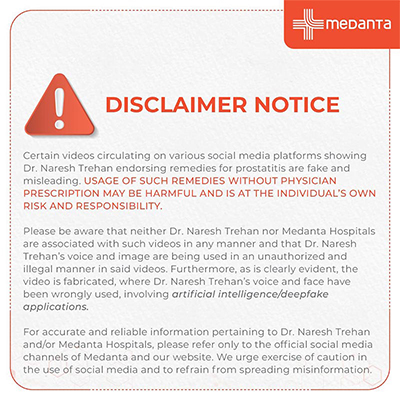Lower Back Pain Causes
TABLE OF CONTENTS
Dr. Vineesh Mathur is the Director and Head of Orthopaedic Spine Surgery at Medanta Hospital, Gurugram. In his expert opinion, there is a growing concern that affects millions of office workers worldwide - lower back pain causes and how to prevent them.
For those who have recently graduated with a management degree and landed their dream job, Dr. Mathur offers congratulations but also a word of caution. While these young professionals are eager to prove themselves in new office environments, working tirelessly to make their mark, they should be aware of certain health risks.
Dr. Mathur points out that within just three years of starting an office job, approximately 70% of people begin to complain of back pain, neck pain, headaches, and generalised body aches. This statistic is alarming but not surprising given the nature of modern work environments.
Stress and Anxiety: The Silent Culprits
According to Dr. Mathur, most people are naturally anxious to perform well at their jobs. The constant pressure of deadlines, performance expectations, and the desire to outshine colleagues creates a perfect storm for physical problems. This ongoing, unrelenting stress is a major contributor to back, neck, and musculoskeletal issues.
Dr. Mathur explains that when a person is stressed, their muscles tense up. Many of his patients report feeling completely drained after completing a major project. This happens because, during those intense 12-hour workdays, they unconsciously grit their teeth and tense their muscles. When the work finally ends, and the muscles relax, they feel absolutely lifeless.
The specialist emphasises that learning to control stress is crucial as it’s one of the biggest lower back pain reasons in office environments. The connection between mental stress and physical pain is real and significant.
The Sedentary Lifestyle Epidemic
Dr. Mathur observes that as smoking rates decline in the Western world, so too does the number of people performing physically active jobs. Most modern professions are IT-based or heavily reliant on IT. Even construction workers who once engaged in physical labour now spend their days sitting and operating equipment with joysticks.
He notes that every profession is increasingly becoming mechanised, digitised, and computer-based, involving extended periods of sitting. This sedentary lifestyle is a primary factor in what causes lower back pain for office workers.
Break the Sitting Cycle
The orthopaedic surgeon advises trying to avoid sitting for more than one to one and a half hours at a stretch. He recommends staying active throughout the workday and avoiding the temptation to complete all tasks without getting up from the desk.
For example, Dr. Mathur suggests that if someone needs to share a spreadsheet with a colleague, they should consider printing it and walking it over to their desk instead of emailing it. These small breaks in the sitting routine give overworked muscles a chance to recover.
Ergonomics: Your First Line of Defence
Dr. Mathur emphasises that proper ergonomics are essential for preventing back pain. He advises ensuring:
Good lighting
Appropriate desk height
A supportive chair
A computer screen positioned at eye level
These simple adjustments can significantly reduce strain on back and neck muscles.
Movement and Exercise
Taking inspiration from industrial workers of the last century, Dr. Mathur recommends incorporating regular loosening exercises into the workday. He mentions that there are many helpful videos available online demonstrating quick exercises that can be done at a desk.
After a couple of hours of work, if someone feels tense or stressed, the doctor suggests taking a few minutes to perform these exercises. They’ll help loosen muscles and prevent pain from developing.
Dr. Mathur points out that even the choice of footwear plays a crucial role in maintaining back health. The desire to wear fashionable shoes like high heels or difficult-to-balance footwear can put significant strain on the muscles of the calves, thighs, lower back, and glutes.
While looking stylish is certainly not a bad thing, he advises considering sensible, flat shoes that are friendly to the back, hips, and knees, especially during long workdays.
Taking Control of Your Back Health
The specialist concludes that the modern office environment presents unique challenges to physical well-being, particularly when it comes to lower back pain. By understanding these challenges and implementing simple preventive measures, professionals can enjoy successful careers without sacrificing their health.
Dr. Mathur reminds us that small changes make a big difference: regular movement breaks, proper ergonomics, stress management techniques, appropriate footwear, and simple exercises can all help keep back pain at bay.
As people embark on their professional journeys, Dr. Mathur encourages them to make physical health a priority alongside career goals. Their future selves will thank them for it.
Why do so many office workers struggle with lower back pain?
Long hours of sitting—often with poor posture—place constant strain on the spine and surrounding muscles. Combined with high-stress levels and limited movement, this creates the perfect storm for persistent back pain.
What are simple ways to prevent back pain at work?
Small changes in daily life can prevent back pain, including:
Taking short movement breaks every 1–1.5 hours
Maintain good posture while working
Set up an ergonomic workspace
Wear appropriate footwear
Perform simple exercises and stretches
Can footwear impact back pain?
Absolutely. Wearing high heels or unsupportive shoes can throw off your posture & put extra strain on your legs, hips, and lower back. Supportive, flat shoes help maintain better alignment and reduce the risk of back pain—especially during long workdays.





